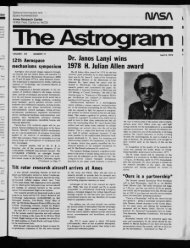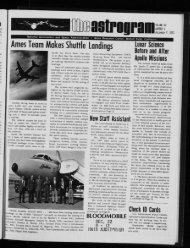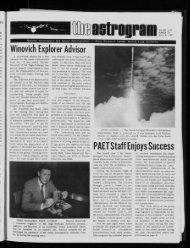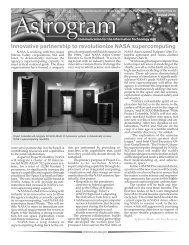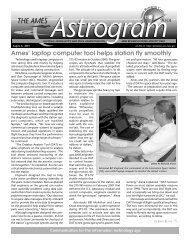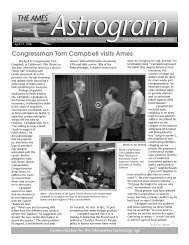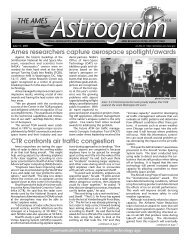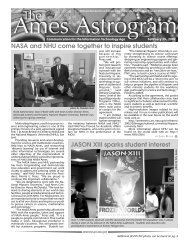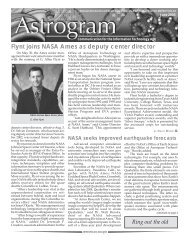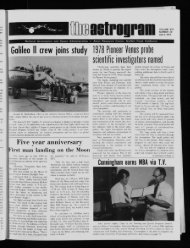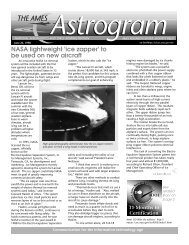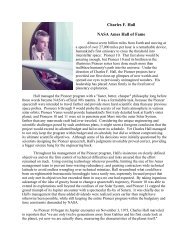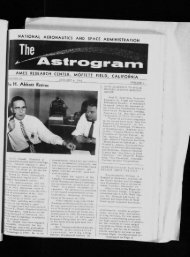3/12/01 Astrogram - NASA Ames History Office
3/12/01 Astrogram - NASA Ames History Office
3/12/01 Astrogram - NASA Ames History Office
You also want an ePaper? Increase the reach of your titles
YUMPU automatically turns print PDFs into web optimized ePapers that Google loves.
THE AMES<br />
March <strong>12</strong>, 20<strong>01</strong><br />
<strong>Astrogram</strong><br />
NATIONAL AERONAUTICS AND SPACE ADMINISTRATION AMES RESEARCH CENTER, MOFFETT FIELD<br />
March <strong>12</strong>, 20<strong>01</strong> on-line at: http://amesnews.arc.nasa.gov<br />
Scientists find strong evidence of microbial life on Mars<br />
An international team of researchers has<br />
discovered compelling evidence that the<br />
magnetite crystals in the martian meteorite<br />
ALH840<strong>01</strong> are of biological origin.<br />
The researchers found that the magnetite<br />
crystals embedded in the meteorite are<br />
arranged in long chains, which they say<br />
could have been formed only by onceliving<br />
organisms. Their results were reported<br />
in the latest issue of the Proceedings of the<br />
National Academy of Sciences (PNAS).<br />
"The chains we discovered are of biological<br />
origin," said Dr. Imre Friedmann, an<br />
NRC senior research fellow at <strong>Ames</strong> and<br />
leader of the research team. "Such a chain<br />
of magnets outside an organism would<br />
immediately collapse into a clump due to<br />
magnetic forces," he said.<br />
The chains were formed inside organic<br />
material whose structure held the crystals<br />
together. "The end result looks somewhat<br />
like a string of pearls," Friedmann noted.<br />
Each magnetite crystal in the chain is a tiny<br />
magnet, approximately one-millionth of<br />
an inch in diameter. Magnetite is an iron<br />
oxide, similar to iron rust.<br />
The chains may have served as<br />
'compasses' for the host<br />
magnetotactic bacteria, so named<br />
because they navigate with the help<br />
of the magnetic crystal chains inside<br />
their bodies. The chains were<br />
preserved in the meteorite long after<br />
the bacteria themselves decayed.<br />
The researchers say the magnetite<br />
chains probably were flushed<br />
into microscopic cracks inside the<br />
martian rock after it was shattered<br />
by an asteroid impact approximately<br />
3.9 billion years ago. This cataclysmic<br />
event on Mars' surface also may<br />
have killed the bacteria. The same,<br />
or a later, asteroid impact ejected<br />
the rock, now a meteorite, into<br />
space.<br />
Another <strong>NASA</strong> research group,<br />
led by Kathie Thomas-Keprta of<br />
<strong>NASA</strong>'s Johnson Space Center, reported<br />
in the same issue of PNAS<br />
continued on page 5<br />
Congressman Mike Honda visits <strong>Ames</strong><br />
On March 23, Congressman Michael<br />
Honda (D-San José) and members of his<br />
staff visited <strong>Ames</strong>. Accompanied by Center<br />
Deputy Director Bill Berry, the congressman<br />
toured FutureFlight Center (FFC), the<br />
Neural Engineering Lab and the Numeri-<br />
Deputy Center Director William Berry (left)<br />
with Congressman Mike Honda (right).<br />
cal Aerospace Simulation (NAS) Systems<br />
Facility.<br />
At the FFC, Nancy Dorighi briefed the<br />
congressman on the latest tests simulating<br />
the Los Angeles International Airport control<br />
tower. While in the tower, Honda<br />
donned a controller’s headset to listen in<br />
on communications traffic.<br />
At the Neural Engineering Lab, Joe Totah<br />
explained the benefits of neural net software<br />
for aviation safety and demonstrated<br />
the software using the lab’s vision dome.<br />
The last stop on the tour was the NAS<br />
supercomputer/Vis Lab where William<br />
Feiereisen presented the division’s work<br />
with simulations of carbon nanotubes. In<br />
the Vis Lab, Honda manipulated carbon<br />
nanotubes in a virtual 3-D environment.<br />
Honda, a former teacher and state assemblyman,<br />
previously visited <strong>Ames</strong> as a<br />
speaker at the Space Technology and Education<br />
day in July 1999. Currently, Honda<br />
is a member of the Transportation Committee<br />
with specific duties on the aviation,<br />
highway and transit and water resources<br />
sub-committees.<br />
Although Honda was fighting a cold<br />
during the tour, he was engaged and participated<br />
in all of the technology demonstrations.<br />
He was impressed with the tour<br />
Upper figure: modern magnetotactic bacteria, one<br />
showing a chain of magnetite crystals, as seen in the<br />
backscattered scanning electron microscope. Lower<br />
figure: magnetite crystals and chains of magnetite crystals<br />
in the martian meteorite ALH840<strong>01</strong> in the backscattered<br />
scanning electron microscope. One conspicuous chain is<br />
indicated by the circle. The diameter of a single crystal is<br />
approximately one-millionth of an inch.<br />
photos by Jonas Diño<br />
Chris Henze, senior research scientist in the NAS<br />
Division (left) demonstrates to Congressman Mike<br />
Honda (right, with stereo glasses) a computational<br />
steering application on the 3-D immersive work<br />
bench. Michael Marlaire (center), Chief of the<br />
Development and Communication <strong>Office</strong>, looks on.<br />
and the cutting-edge technologies being<br />
developed here at <strong>Ames</strong>.<br />
BY JONAS DIÑO<br />
Communication for the information technology The age <strong>Ames</strong> <strong>Astrogram</strong> — 1
Science & Research<br />
<strong>Ames</strong> sends first hardware to<br />
International Space Station<br />
<strong>Ames</strong> sent its first space hardware to the<br />
International Space Station (ISS) on the<br />
Space Shuttle Discovery in early March.<br />
The passive dosimeter system (PDS) will<br />
The electronic reader (shown above) that<br />
measures accumulated radiation dose in a<br />
termoluminescent detector. The Hungarian<br />
Space <strong>Office</strong> provided the reader to <strong>NASA</strong>.<br />
serve as a flexible and easy-to-use radiation<br />
monitor available for use by any researcher.<br />
It also will serve as a useful complement to<br />
existing dosimetry used for routine ISS operations.<br />
The hardware consists of two kinds<br />
of radiation detectors (dosimeters) and an<br />
electronic “reader.” The dosimeters can be<br />
placed anywhere in the ISS to provide an<br />
accurate measurement of the radiation at<br />
their locations.<br />
“Monitoring radiation exposure is important<br />
both to crew health and to future<br />
scientific research on the ISS,” said PDS<br />
payload manager Robert Jackson of <strong>Ames</strong><br />
Code SFE. “These dosimeters can stay on<br />
the station indefinitely, and they will be<br />
available to scientists in a variety of fields,”<br />
he continued.<br />
Understanding the radiation environment<br />
on the ISS will help scientists explain<br />
experimental results that otherwise might<br />
be unaccounted for. The radiation measurements<br />
can help scientists determine<br />
whether a given effect is due to microgravity,<br />
radiation or something else. The PDS will be<br />
part of <strong>NASA</strong>’s laboratory support equipment<br />
and will be available to all ISS partners’<br />
life science investigators.<br />
One type of radiation dosimeter is a<br />
thermoluminescent detector or TLD. Each<br />
TLD, which resembles a fat fountain pen,<br />
contains calcium sulfate crystals inside an<br />
evacuated glass bulb. These crystals absorb<br />
energy from incident ionizing radiation (protons,<br />
neutrons, electrons, heavy charged<br />
particles, gamma rays and x-rays) as the<br />
radiation passes through them. This process<br />
results in a steady increase in the energy<br />
level of the electrons in the crystal.<br />
To read the accumulated radiation dose,<br />
an astronaut aboard the ISS removes the<br />
crystal-containing dosimeter from its mea-<br />
surement location and places it<br />
into the electronic reader. A<br />
component inside the reader<br />
heats the crystals. As they are<br />
heated, the crystals emit a glow<br />
of light proportional to the<br />
amount of radiation to which<br />
they were exposed. A photomultiplier<br />
tube in the reader<br />
measures this glow. The reader<br />
stores the measured dose on a<br />
memory card that can be returned<br />
to Earth for further analysis.<br />
After the crystals have emitted<br />
all the stored energy, they are ready to<br />
begin accumulating another dose and the<br />
TLD is ready to be reused.<br />
The other dosimeters are plastic nuclear<br />
track detectors (PNTDs) — thin sheets of<br />
plastic similar to the material used for some<br />
eyeglass lenses. As heavy charged ions pass<br />
through the PNTDs, the surface becomes<br />
pitted with tiny craters. After the detectors<br />
are returned to Earth, the plastic is etched<br />
to enlarge the craters, which are counted<br />
and their shapes and sizes are analyzed<br />
using a microscope. This information is<br />
used to improve the accuracy of the radiation<br />
dose the TLDs have recorded and to<br />
improve the estimate of the biological effects<br />
of the radiation.<br />
STS-102, which launched March 8<br />
launch, carried the complete set of 48 TLDs<br />
and the reader to the ISS, where they will<br />
remain indefinitely to support a variety of<br />
future scientific experiments. A set of <strong>12</strong><br />
PNTDs will be carried to the ISS on STS-100<br />
later this year. The combined dosimeters<br />
will be used to measure radiation as part of<br />
the DOSMAP experiment, which is being<br />
conducted by the <strong>NASA</strong> Human Research<br />
Thermoluminescent radition detector is shown in a PNTD<br />
holder that allows it to be placed in different locations<br />
inside the International Space Station.<br />
Facility on the ISS. The exposed PNTDs will<br />
be returned to Earth by the STS-105 mission<br />
for later analysis.<br />
The Hungarian Space <strong>Office</strong> provided<br />
the thermoluminescent detectors, which<br />
are a third-generation version of dosimeters<br />
that flew on the Russian space stations<br />
Salyut 7 and Mir, and on the space shuttle.<br />
The Hungarian Space <strong>Office</strong> also provided<br />
the compact radiation reader, which is<br />
smaller than a typical shoebox. The PNTDs<br />
are provided and analyzed by ERIL Research<br />
Company, San Rafael, CA.<br />
<strong>Ames</strong> has led efforts to verify and certify<br />
the dosimeters for safety, and to package<br />
them in one of four transport containers,<br />
which resemble insulated lunch bags. One<br />
container holds a reader and <strong>12</strong> TLDs with<br />
associated power and data cables. Two<br />
additional kits each hold 18 TLDs. The final<br />
kit holds <strong>12</strong> PNTDs and 2 memory cards for<br />
the reader.<br />
“This is just the first step in a series of<br />
hardware <strong>Ames</strong> will be sending to ISS to<br />
support fundamental biology research,”<br />
Jackson said.<br />
Shih receives service award<br />
BY ANN HUTCHISON<br />
On Feb.16, John McGraw of the Federal Aviation Administration (FAA), who led the 737<br />
flight controls engineering test and evaluation board, presented an award to K.C. Shih<br />
(<strong>Ames</strong> Code ARH) for his service as chairperson of the challenge team.<br />
2 — The <strong>Ames</strong> <strong>Astrogram</strong> March <strong>12</strong>, 20<strong>01</strong><br />
photo by Dominic Hart
Gazlay passes on<br />
<strong>Ames</strong> has lost a key contributor, enthusiast<br />
technician and skilled craftsman with<br />
the passing of David N. Gazlay on February<br />
13, 20<strong>01</strong>. He was just 43 years old.<br />
Gazlay started at <strong>Ames</strong> in 1975 as a<br />
Foothill-De Anza student intern. He completed<br />
his internship while working with<br />
journeymen in the trade in the structural<br />
fabrication section. Upon completion of<br />
the intern program, Gazlay worked for Varian<br />
Associates for two years before returning to<br />
<strong>Ames</strong> in 1980.<br />
Shortly after he returned to <strong>Ames</strong>, Gazlay<br />
was the technician assigned to a project to<br />
develop a model for the inlet vanes for the<br />
80 x <strong>12</strong>0 wind tunnel. Several years later,<br />
he joined a team that developed the frog<br />
embryology unit (FEU). Gazlay took great<br />
pride in finding solutions to the problems<br />
encountered on the hardware. For example,<br />
there was a problem in cleaning<br />
some tight areas in an assembly and performing<br />
an inspection. His responsibility<br />
did not include finding a solution for these<br />
problems, but on the Saturday that the<br />
engineers were working on the solutions,<br />
Gazlay went to a gun shop, picked up a few<br />
rifle bore brushes on his own and brought<br />
them in. He also had figured out a way to<br />
perform the required inspection. Gazlay<br />
won an <strong>Ames</strong> Honor Award for his dedication<br />
and contributions to the success of this<br />
project.<br />
Over the next several years, Gazlay continued<br />
to develop his expertise in aircraft<br />
sheet metal fabrication, quickly assuming<br />
the responsibility of loadmaster for the DC-<br />
8 aircraft. As loadmaster, he was involved<br />
in the design and fabrication of specialized<br />
experiment racks and development of airborne<br />
experimental instruments. He had<br />
an intimate knowledge of the aircraft. Routinely,<br />
experiments had to be ready and<br />
loaded onto the aircraft to meet stringent<br />
flight schedules, dictated by an international<br />
research community, and unloaded<br />
with great care for the hardware and collected<br />
data immediately upon the return of<br />
the plane from deployment. Gazlay would<br />
then start the process again, as the DC-8<br />
itself underwent an ambitious modification<br />
program to prepare it for an entirely new set<br />
of experiments. One time, he had to prepare<br />
the aircraft for instruments by cutting<br />
a window in the belly of the aircraft. Gazlay<br />
assisted with the design and then cut the<br />
window, skinned the underside of the aircraft<br />
and fastened these skins using over<br />
7,000 flight certified fasteners to meet stringent<br />
flight requirements for flow and turbulence.<br />
Gazlay also worked on the Waverider<br />
project, a 4.5’ long vehicle that would evaluate<br />
theories about high-speed flight-testing<br />
March <strong>12</strong>, 20<strong>01</strong><br />
Remembrance<br />
and be the best-ever hypersonic waverider<br />
vehicle. Gazlay was asked for his design<br />
and build input by researcher Marc<br />
Murbach.<br />
“I had very little money, crude sketches<br />
on a coffee-stained piece of paper and<br />
some odd pieces of cardboard probably<br />
from a cereal box showing a possible means<br />
of assembly,” Murbach said. “Within a<br />
week we had the material. A lot of Dave’s<br />
design comments and improvements were<br />
incorporated.”<br />
“Dave was one of those people who<br />
worked with zeal and passion, and also<br />
compassion.”<br />
The vehicle is now fully instrumented<br />
and awaiting the rocket ride a little later this<br />
year. This first flight will be dedicated to<br />
Gazlay in honor of his contributions to this<br />
project.<br />
During the course of Gazlay’s career,<br />
his high level of expertise made him a<br />
natural leader and a well-respected mentor<br />
to his colleagues. He continued to develop<br />
and became group leader for the aircraft<br />
sheet metal section where he oversaw many<br />
successful projects and many that came to<br />
fruition through his marketing efforts. On<br />
the DeHavilland-8 Lift project, he stepped<br />
in for another lead person and was at work<br />
until midnight, welding and working on<br />
the lift that had to be in the 80 x <strong>12</strong>0 wind<br />
tunnel the next morning. He worked tirelessly<br />
on his own time, designing and developing<br />
paper models of hardware to<br />
confirm his dimensions and make it easier<br />
for his employees and customers to envi-<br />
sion the final product. He recently designed<br />
and oversaw fabrication of the centrifuge<br />
accommodation module (CAM)<br />
project based entirely on verbal requirements<br />
and photographs provided by Space<br />
photo by Deborah Wood<br />
David N. Gazley, far left, poses with other members of the Frog Embryology Unit<br />
(FEU) team. Shown with Gazley from left to right are Kim Wagenbach, Pearl Cheng,<br />
John Estrada and Jack Connolly.<br />
Station Biological Research Project (SSBRP)<br />
personnel. Gazlay’s last assignment was<br />
the development of a master-scheduling<br />
program for his entire branch and the FM<br />
project manager for SOFIA.<br />
Gazlay was excited about working for<br />
<strong>NASA</strong>. Some say his blood was <strong>NASA</strong> blue.<br />
He was an innovative and creative craftsman<br />
with a talent for practical problem<br />
solving and dedicated to the <strong>Ames</strong> and<br />
<strong>NASA</strong> mission. We have lost a great friend<br />
and colleague. <strong>NASA</strong> has lost a highly<br />
talented contributor.<br />
A memorial scholarship has been set up<br />
in Gazlay’s honor. Contributions can be<br />
sent to:<br />
Wells Fargo Bank<br />
Third Party Deposit<br />
P.O. Box 5629<br />
Portland, OR 97228<br />
Make checks payable to: David Neal<br />
Gazlay Memorial Scholarship Fund, account<br />
#0670072370.<br />
The <strong>Ames</strong> Research Center and American<br />
flag were flown at half mast from 10:00<br />
am to 10:15 am on Saturday, February 17,<br />
20<strong>01</strong> in honor of David's contributions to<br />
<strong>NASA</strong>. They were presented in a private<br />
ceremony to his wife Royanna and family<br />
on Tuesday, Feb. 27, 20<strong>01</strong> by Deputy Center<br />
Director William Berry.<br />
BY DEBBIE WOOD<br />
The <strong>Ames</strong> <strong>Astrogram</strong> — 3
Remembrance<br />
Tad Savage: memories of a friend<br />
The <strong>Ames</strong> Research Center, <strong>NASA</strong> as a<br />
whole and the international space community<br />
lost a valuable friend and colleague<br />
with the passing of Paul “Tad” Savage from<br />
esophageal cancer on Feb. 24, 20<strong>01</strong>. Tad<br />
was 43 years old, and had been at <strong>Ames</strong> for<br />
16 years at the time of his death.<br />
Savage had a varied career which<br />
touched a great number of those at <strong>Ames</strong>.<br />
Tad Savage<br />
photo by Maria Garcia<br />
As a payload engineer for the <strong>Ames</strong> Spacelab<br />
Life Sciences – 1 (SLS-1) payload, he was<br />
responsible for many of the inner workings<br />
of this complex payload, on the first Spacelab<br />
mission dedicated entirely to research in life<br />
sciences. His steady hand and calm demeanor,<br />
plus his unassailably cheery attitude,<br />
endeared him to the many people he<br />
worked with throughout the agency. After<br />
the outstanding success of SLS-1, Savage<br />
stepped up to the even bigger challenge of<br />
managing his own payload – SLS-2. One of<br />
the most complex payloads flown to date,<br />
SLS-2 pushed the state of the art and through<br />
its success – due in large part to Savage’s<br />
energy, creativity and perseverance - obtained<br />
many important research results that<br />
had a large influence on the space biology<br />
community. Once again, he accomplished<br />
his goals through steady, calm leadership,<br />
always with an eye toward what mattered<br />
most in the payload’s success – his team.<br />
His work on this groundbreaking payload<br />
was rewarded with the <strong>NASA</strong> Exceptional<br />
Achievement Medal in 1994.<br />
Savage had always had an interest in<br />
international relations and their impact<br />
on the space program, and was<br />
chosen as the leader of the <strong>NASA</strong>-Mir<br />
fundamental biology project. This<br />
project, conducted jointly with the<br />
Russian space program, was part of<br />
the first phase of the development of<br />
the International Space Station, where<br />
important lessons were learned about<br />
how to conduct long-term space research<br />
projects. Again, through his<br />
integrity and leadership, Savage gained<br />
the respect not only of his <strong>Ames</strong> team<br />
but that of his Russian partners.<br />
Through the success of his efforts, this<br />
work led to an <strong>Ames</strong> honor award for<br />
outstanding group/team achievement<br />
in 1997. In the same year, Savage was<br />
selected for the highly prestigious<br />
James E. Webb Space Administration<br />
Fellowship for International Studies and<br />
honored in a ceremony hosted by<br />
Administrator Goldin.<br />
Although the technical and management<br />
portions of his career were<br />
very important to Savage, of even greater<br />
importance was helping others to achieve<br />
career goals. He served for many years as<br />
the co-lead of the IDEAS programs at <strong>Ames</strong>,<br />
bringing together young and mid-career<br />
level staff from a variety of disciplines for<br />
year-long programs in personal and career<br />
development. He was actively involved<br />
with the outside community in a wide variety<br />
of efforts including the Adopt-A-School<br />
College Relations Team and served as a<br />
recruiter for <strong>Ames</strong> for most of his career. It’s<br />
easy to imagine that Savage’s personal skills<br />
may have convinced quite a few potential<br />
applicants that <strong>Ames</strong> was worth a try!<br />
Savage was a very active sportsman<br />
throughout his life and career and could<br />
often be seen at lunchtime lifting weights at<br />
the gym or running past the wind tunnels<br />
with his <strong>Ames</strong> friends. About the only effort<br />
which he led that was less than a stellar<br />
success was his “Rat Patrol” softball team at<br />
<strong>Ames</strong> - that is, if success is measured in team<br />
victories!<br />
In his final career duties as chief of the<br />
Science Payload Operations Branch for the<br />
past four years, Savage was known and<br />
respected as a leader who always took the<br />
time to listen to those in his branch. No<br />
matter what the problem was, he always<br />
paid close attention and offered good sug-<br />
gestions, and in so doing earned the great<br />
admiration of his staff. As personally related<br />
Tad Savage in Space Shuttle simulator.<br />
to his closest <strong>Ames</strong> friends, his proudest<br />
achievements weren’t just his pathfinding<br />
space payloads, but equally as much, if not<br />
more, the help that he gave to his staff and<br />
friends throughout <strong>NASA</strong>. These values<br />
were reflected back to him in his final weeks<br />
with an incredible outpouring of feelings<br />
for Savage, from Headquarters and all the<br />
centers he worked with, as well as his many<br />
Russian colleagues.<br />
Savage is survived by his wife Donna<br />
and son Christopher, and the many in our<br />
<strong>Ames</strong> community who cared for him and<br />
called him a friend.<br />
BY GREG SCHMIDT<br />
VPP STAR Tip:<br />
"VPP participants enter into a new<br />
relationship with OSHA. In this<br />
innovative public/private<br />
partnership, cooperation and trust<br />
nourish improvements in safety<br />
and health, not just at VPP sites,<br />
but also beyond the worksite<br />
boundaries." …Federal Register<br />
65:45649-45663<br />
4 — The <strong>Ames</strong> <strong>Astrogram</strong> March <strong>12</strong>, 20<strong>01</strong>
On-site Events<br />
Engineering Evaluation Laboratory hosts open house<br />
The entire <strong>Ames</strong> community is invited<br />
to a day of live demonstrations, self-guided<br />
tours and informative discussions about the<br />
most unique engineering laboratory at<br />
<strong>Ames</strong>. The open house for the Engineering<br />
Evaluation Laboratory (EEL), Code FEE, will<br />
The Impac shock machine provides<br />
impact results from dropping test items<br />
onto various density pads, producing<br />
shock pulses up to 3000g. Howard<br />
Menche, lab manager, is shown here<br />
operating the shock machine.<br />
be held in the hi-bay of building N-244,<br />
March 29, from 10 a.m. - 2 p.m. The EEL is<br />
the environmental test facility that has supported<br />
both the research and development<br />
March <strong>12</strong>, 20<strong>01</strong><br />
of hardware and the modernization<br />
of facilities at <strong>Ames</strong> for<br />
over 33 years.<br />
The EEL was originally<br />
known as the Reliability and<br />
Quality Assurance (R&QA) Lab,<br />
established in 1967 as a test<br />
facility to support the Pioneer<br />
missions. The original five pieces<br />
of equipment included a 200g<br />
centrifuge, a vibration table, a<br />
shock machine, an altitude/<br />
temperature chamber and a<br />
humidity/temperature chamber.<br />
This provided the basic<br />
environmental capabilities for<br />
the research and development<br />
of Pioneer space hardware and<br />
insured reliability and quality<br />
assurance to the final flight instruments.<br />
Since that humble beginning,<br />
EEL has acquired substantially<br />
more equipment and expertise,<br />
enhancing and expanding into many<br />
areas of engineering to assist in the development<br />
and evaluation of hardware and<br />
the instrumentation needs of many of the<br />
facilities on the center.<br />
Today, in addition to environmental testing,<br />
the EEL can also provide large-scale and<br />
small-scale strain gaging, high-precision instrumentation<br />
for mechanical and thermal<br />
quantities, structural testing of mechanical<br />
components and systems, modal analysis,<br />
specialized calibrations, mass property measurements<br />
and data acquisition and analysis.<br />
Lab staff will be on hand to demonstrate<br />
and discuss the unique capabilities of the<br />
photos by Tom Trower<br />
engineering, instrumentation, measurement<br />
and environmental concerns of customer<br />
projects. From the days of providing<br />
engineering support on flight instruments<br />
flown on Pioneer Venus and the Galileo<br />
Probe, to the ultra small strain gaging of<br />
serpentine robots or the evaluation of the<br />
frictional loads on bearings for the SOFIA<br />
telescope door, the EEL can help the <strong>Ames</strong><br />
community with its engineering test needs.<br />
If you are interested in learning more<br />
about the research and development of<br />
flight and ground-based hardware, testing<br />
in extreme environments and visiting a<br />
one-of-a-kind test facility, this open house<br />
is for you.<br />
EEL and to explore potential solutions to the BY JERRY WANG<br />
Scientists find strong evidence of microbial life on Mars<br />
continued from front page<br />
that the magnetite crystals inside the meteorite<br />
are similar to those formed by 'modern'<br />
magnetotactic bacteria now living on<br />
Earth. The team studied only single crystals,<br />
however, not the elusive chain-like structures.<br />
Friedmann's team discovered the crystal<br />
chains using a technique that enabled them<br />
to 'see' the tiny chains inside the meteorite<br />
without destroying them. Besides the chainlike<br />
formation, the team discovered that<br />
individual crystals are of similar size and<br />
shape, do not touch each other and that the<br />
chains themselves are flexible, further evidence<br />
of biological origin.<br />
"Until now, studying life has been like<br />
trying to draw a curve using only one data<br />
point --life on Earth," said Friedmann. "Now<br />
we have two data points to draw life's curve.<br />
The next step is to find the remains of the<br />
bacteria themselves,” he said.<br />
The fact that a small (about 4-pound)<br />
meteorite from a planet contains large numbers<br />
of bacteria suggests that such bacteria<br />
were widespread on the surface of Mars,<br />
according to the researchers. A stone of<br />
similar size from Earth would contain many<br />
bacteria.<br />
In addition, since magnetotactic bacteria<br />
require low levels of oxygen, this finding<br />
indicates that photosynthetic organisms,<br />
the source of oxygen in the atmosphere,<br />
must have been present and active on Mars<br />
3.9 billion years ago.<br />
"Finding evidence of life on Mars is one<br />
of the central problems in astrobiology research<br />
today," said Dr. Michael Meyer, head<br />
of <strong>NASA</strong>'s astrobiology program, which<br />
funded the research.<br />
In addition to his fellowship at <strong>Ames</strong>,<br />
Friedmann, who is best known for discovering<br />
microorganisms living inside desert<br />
rocks, is professor emeritus of biological<br />
science at Florida State University. Mem-<br />
The Ling vibration table can produce vibration levels<br />
equivalent to a space shuttle launch, or to levels matching<br />
various mission profiles. Howard Menche, lab manager, is<br />
shown here at the vibration table.<br />
bers of the research team included Dr. Jacek<br />
Wierzchos (University of Lleida, Spain), Dr.<br />
Carmen Ascaso (CSIC, Madrid, Spain) and<br />
Dr. Michael Winkelhofer (University of<br />
Munich, Germany).<br />
The meteorite ALH840<strong>01</strong> was found in<br />
the Allan Hills region of Antarctica in 1984<br />
by researchers supported by the National<br />
Science Foundation's Antarctic Search for<br />
Meteorites Program, a joint effort by the<br />
NSF, the Smithsonian Institution and <strong>NASA</strong>.<br />
The Case Western Reserve University in<br />
Cleveland manages the program.<br />
Full text of the research paper is available<br />
at: http://www.pnas.org<br />
<strong>Ames</strong> is <strong>NASA</strong>'s lead center for astrobiology,<br />
the study of the origin, evolution,<br />
distribution and future of life in the universe.<br />
<strong>Ames</strong> is the location of the central<br />
offices of the <strong>NASA</strong> Astrobiology Institute,<br />
an international research consortium.<br />
BY KATHLEEN BURTON<br />
The <strong>Ames</strong> <strong>Astrogram</strong> — 5
Computer Technology<br />
IPG team reaches large-scale computer milestone<br />
<strong>NASA</strong>’s Information Power Grid (IPG)<br />
team achieved a major milestone at the end<br />
of December with the successful integrating<br />
of the updated SGI Origin 2000, Lomax,<br />
into the grid’s infrastructure. Lomax, with<br />
5<strong>12</strong> processors running at 400 megahertz<br />
each, is the second large-scale machine to<br />
be incorporated into <strong>NASA</strong>’s IPG. After integrating<br />
Lomax into the IPG production<br />
environment, the team was able to demonstrate<br />
its capabilities in conjunction with<br />
two other distributed IPG resources (one<br />
each at <strong>NASA</strong>’s Langley and Glenn Research<br />
Centers), to solve a multi-part aerospace<br />
research problem (see figure).<br />
IPG resources Sharp, a 24-processor SGI<br />
Origin 2000 at Glenn Research Center in<br />
Ohio, and Whitcomb, an 8-processor SGI<br />
Origin 2000 at Langley Research Center in<br />
Virginia, were used in concert with Lomax<br />
to solve complex aerospace geometries.<br />
The configurations were calculated using<br />
the computer code OVERFLOW, version D<br />
(see sidebar). This particular version of OVER-<br />
FLOW is designed specifically to take advantage<br />
of parallel and distributed computing<br />
resources by limiting the number of<br />
processors that can be used at any one time.<br />
Using a small number of processors on<br />
three distributed machines is an effective<br />
application of under-utilized resources. Using<br />
several grid resources for a job reduces<br />
turnaround time and creates a distributed,<br />
collaborative problem-solving environment.<br />
This approach to computing is also more<br />
cost-effective.<br />
“This will enable us to calculate a complex<br />
aerospace problem much faster by<br />
using all three of the machines,” explains<br />
Arsi Vaziri, IPG deputy project manager.<br />
Data is important too…in addition to<br />
demonstrating integration of a large<br />
supercomputer into the IPG structure, this<br />
milestone illustrates the importance of data<br />
transfer between remote resources.<br />
“Our approach to the IPG is geared<br />
toward an equal emphasis on data transmission<br />
and computational speed,” explains<br />
Vaziri. Many of <strong>NASA</strong>’s newer research<br />
programs rely heavily on cross-center collaboration<br />
and IPG provides an economical<br />
method for sharing data between colleagues<br />
at remote locations.<br />
“Agency-wide programs like ISE (intelligent<br />
synthesis environment) are essentially<br />
advanced design, or computer design<br />
projects for <strong>NASA</strong>’s aerospace enterprise,<br />
and that’s what we’re targeting--a computing<br />
environment that enables application<br />
domains to work with a large collection of<br />
machines, including supercomputers,” ex-<br />
plains Bill Johnston, IPG project manager.<br />
The Globus middleware package,<br />
designed to enable different types of<br />
IPG resources to interface with each<br />
other, was installed on Lomax with very<br />
few software changes.<br />
“Globus enables the IPG team to<br />
run easily any computational code and<br />
transfer data between Lomax, Sharp<br />
and Whitcomb,” explains Johnston.<br />
In addition to having the ability to<br />
transfer code and data easily, IPG users<br />
now have a collection of distributed<br />
resources, located at the three <strong>NASA</strong><br />
centers, to reduce end-to-end turnaround<br />
time for aerospace design and<br />
simulation problems. The next milestone,<br />
scheduled to be met in September<br />
20<strong>01</strong>, will incorporate an electron<br />
microscope located at the University of<br />
California at San Diego into the grid’s<br />
infrastructure to facilitate experiments requiring<br />
high data-transfer rates using the<br />
One of the large-scale OVERFLOW applications<br />
the IPG team used to demonstrate<br />
the successful completion of the December<br />
milestone was a Navier-Stokes computational<br />
fluid dynamics (CFD) simulation<br />
of flow about a generic reusable launch<br />
vehicle. The simulation was run using a<br />
distributed version of OVERFLOW, version<br />
D, which required 215 grids, or computational<br />
meshes and about 14 million grid<br />
points (see figure below). Without OVER-<br />
FLOW-D, this application could not have<br />
been run on multiple machines. Running<br />
this aerospace configuration with the recently<br />
integrated 5<strong>12</strong>-processor Origin<br />
Wind tunnel flow simulation of a wing-body<br />
model encompassing 32 zones and 9 million grid<br />
points.<br />
IPG provides aggregated computing in a parallel<br />
and distributed fashion. The grid can effectively use<br />
underutilized resources, decrease computational<br />
turnaround time, support a collaborative problemsolving<br />
environment, and provide more costeffective<br />
computing solutions<br />
IPG’s high-performance computing systems.<br />
OVERFLOW IPG applications<br />
BY HOLLY A. AMUNDSON<br />
2000 verifies that the IPG is a true application<br />
environment.<br />
The team also used a wind tunnel<br />
flow simulation of a high-lift wing configuration,<br />
which required 32 computational<br />
grids and nearly nine million grid<br />
points. (See figure below). This type of<br />
high-fidelity CFD code provides significant<br />
gains for the aerospace industry by<br />
reducing design-cycle time.<br />
Visualization of a generic reusable launch<br />
vehicle X-38 flow simulation — 215 zones<br />
and 14 million points.<br />
6 — The <strong>Ames</strong> <strong>Astrogram</strong> March <strong>12</strong>, 20<strong>01</strong>
Event Calendar<br />
Model HO/HOn3 Railroad Train Club at Moffett<br />
Field invites train buffs to visit & join the club in Bldg. <strong>12</strong>6,<br />
across from the south end of Hangar One. Work nights are<br />
usually on Friday nights from 7:30 p.m. to 9:30 p.m. Play<br />
time is Sunday from 2 p.m. to 4 p.m. For more info, call<br />
John Donovan at (408) 735-4954 (W) or (408) 281-2899<br />
(H).<br />
Jetstream Toastmasters, Mondays, <strong>12</strong> noon to 1<br />
p.m., N-269/Rm. 179. Guests welcome. POC: Samson<br />
Cheung at ext. 4-2875 or Lich Tran at ext. 4-5997.<br />
<strong>Ames</strong> Bowling League, Tuesdays, at 6 p.m. at Palo<br />
Alto Bowl. Bowlers needed. POC: Mina Cappuccio at ext.<br />
4-1313 or Carmen Park at ext. 4-<strong>12</strong>15.<br />
<strong>Ames</strong> Ballroom Dance Club. Tuesdays: Salsa 3/13,<br />
3/20 & 3/27. 3 levels of classes, from Beg. to Int., 5:15<br />
p.m. - 6:45 p.m. Classes in building 944, the Recreation<br />
Center. Women dancers are especially encouraged to join.<br />
POC: Helen Hwang at: hwang@dm1.arc.nasa.gov.<br />
<strong>Ames</strong> Classifieds<br />
Ads for the next issue should be sent to<br />
astrogram@mail.arc.nasa.gov by the Monday following<br />
publication of the present issue and must be<br />
resubmitted for each issue. Ads must involve personal<br />
needs or items; (no commercial/third-party ads) and<br />
will run on space-available basis only. First-time ads are<br />
given priority. Ads must include home phone numbers;<br />
<strong>Ames</strong> extensions and email addresses will be<br />
accepted for carpool and lost & found ads only. Due<br />
to the volume of material received, we are unable to<br />
verify the accuracy of the statements made in the ads.<br />
Housing<br />
3 bd/1.5 ba, 2-story townhouse on Luz Avenue, San<br />
José. Freshly painted inside, dishwasher, gas heat, w/w<br />
carpeting, outside child play area/large patio. 1 car port.<br />
Easy access to H1<strong>01</strong>/680/280. $295K. Azucena Guzman<br />
(408) 559-2881.<br />
NRC senior research associate & spouse seek a<br />
furnished 2 bdrm apartment or house, Feb 1 to end July<br />
20<strong>01</strong>. Interested in buying/leasing a cheap, used car for<br />
this period. Sophie Wuerger, email to:<br />
s.m.wuerger@keele.ac.uk or phone (+44 1782 752299 or<br />
+44 1782 584214) or by fax (+44 1782 583055).<br />
Fully furnished 2 bd/1ba house in Sunnyvale, 15<br />
min. to <strong>NASA</strong>/Stanford. Avail. Aug 20<strong>01</strong> to Aug 2002.<br />
Storage, fruit trees & outdoor Jacuzzi w/priv. fence.<br />
Gardner, hottub, computer, stereo, TV, dishes & all utils<br />
included in $2,600 mo. rent. Option to use sporty 1997<br />
Honda del Sol, $300/mo. Call (408) 733-0304.<br />
Looking for a place to share on a long-term basis,<br />
three to five years in the surrounding area of Moffett. Will<br />
house sit pets, clean pools, anything that will compensate<br />
the high rent. Looking for the first of May and no later<br />
than May 15. Call (650) 604-0662.<br />
Transportation<br />
'70 VW convertible classic, original owner, no smog<br />
needed; transmission ok; needs work on top & possibly<br />
engine. $1,600. Esther or Art (650) 961-2732.<br />
’72 Mercedes Benz 280 SE (4.5 L, gas engine), 180K<br />
mls. Silver and black classic, single owner for 27 years!<br />
Sunroof, power windows/doors, leather and wood<br />
interior, engine runs well and well maintained. $2,000 or<br />
B/O. David (650) 851-9202.<br />
‘89 Toyota Tercel, $<strong>12</strong>95. White, 2-door<br />
coupe,<strong>12</strong>7,000 mls. Runs great. Gd exterior. Good, very<br />
clean interior. 5-speed manual transmission, A/C, new<br />
stereo. Call (408) 248-3680.<br />
'89 Jeep Cherokee Laredo 4x4, 6cyl 4.0 ltr engine in<br />
good condition, loaded. Original owner, 148K mls,<br />
$5,000 or B/O. (408) 296-1146<br />
‘90 Toyota pickup, deluxe, blue/blue, regular cab,<br />
short bed, 4x4, V6, 5 spd manual, bedliner, AC, rblt eng/<br />
trans, new clutch. $5,000. Mike (408) 226-7839 eves.<br />
‘96 Nissan 200 SX coupe, black, 5 speed, 140 hp,<br />
power everything, sunroof, 70 K $8,800. Barbara (415)<br />
552-8968.<br />
March <strong>12</strong>, 20<strong>01</strong><br />
Calendar & Classifieds<br />
<strong>Ames</strong> Diabetics (AAD), meet twice a month on first &<br />
third Wednesdays, <strong>12</strong> noon to 1 p.m., in the <strong>Ames</strong> Café, far<br />
corner of Sun room. Peer support group that discusses news<br />
that affects diabetics, both type I and II & exchange<br />
experiences in treatment & control & help each other best<br />
cope with the disease. No cost, sales people, leader or medical<br />
professionals. Attend a meeting or call Bob Mohlenhoff at ext.<br />
4-2523, or email him at bmohlenhoff@mail.arc.nasa.gov.<br />
<strong>Ames</strong> Child Care Center Board of Directors Mtg,<br />
Every other Thursday (check website for meeting dates: http:/<br />
/accc.arc.nasa.gov), <strong>12</strong> noon to 2:00 p.m., N269, rm. 2<strong>01</strong>.<br />
POC: Katharine Lee, ext 4-5051.<br />
<strong>Ames</strong> Amateur Radio Club, Mar 15, <strong>12</strong> noon, T28-N<br />
(across from N-255). POC: Michael Wright, KG6BFK, at ext. 4-<br />
6262. URL: http://hamradio.arc.nasa.gov<br />
NFFE Local 997 Union General Mtg, Mar 21, noon to<br />
1 p.m., Bldg. 19/Rm. 2<strong>01</strong>7. Guests welcome. POC: Marianne<br />
Mosher at ext. 4-4055.<br />
Miscellaneous<br />
Wanted: wooden bunk bed with mattresses, with<br />
full-size bottom bunk. Email: copernicus7@hotmail.com<br />
Vintage Heathkit; SA-2020 antenna tuner with<br />
manual, $175; HM 102 HF power meter w/remote head<br />
$60; IM-16 Solid State voltmeter $45, AM-2 reflected<br />
power/SWR meter, $30. Call (650) 851-5290 after 6 p.m.<br />
Windsurfer, Alpha Int'l, made in Austria, 5.5 sail, has<br />
several foot straps. Comes with trapeze harness, excellent<br />
condition. $350. Call (408)-269-8556 eves.<br />
Beautiful credenza, 20” x 30” x 46”, honey-laquer<br />
finish, only a few months old, mint cond., will sell for<br />
60% of orig. cost. Matching chair w/armrest, honeylaquer<br />
finish, mint condition, will sell for 50% of orig.<br />
cost. Call (650) 473-0604.<br />
25 inch color TV, $85. Zenith, works fine, includes<br />
universal remote. Call (408) 248-3680.<br />
King-sized, six-drawer platform bed w/new, top-ofline,<br />
pillow-top mattress. $800. John H, (408) 245-3381.<br />
‘99 Civic Si factory spring set $40. Inexpensive way<br />
to upgrade the handling of your DX or EX. Call (650)<br />
851-5290 after 6 p.m.<br />
Dining room table, $<strong>12</strong>0. Light pine with white tile<br />
top. Wood desk with smooth glass top, blue/green. 5<br />
drawers and pull-out writing surface. $75. Call (650)<br />
949-0793.<br />
Freezer for sale: stand up freezer, almond color,<br />
approx 17 cu ft., works fine, $50. Terry (831) 336-2216.<br />
Can't jog because it's raining? Buy my fitness<br />
trampoline, good condition, has handle. $20. Esther<br />
(650) 961-2732.<br />
Fitness trampoline. Foldable, still in box. $200. Call<br />
(415) 826-3041.<br />
Mini motor-home, self-contained. 97K mls on '87<br />
Ford Econoline engine. $13K or B/O. Call (415) 826-<br />
3041.<br />
Lost & Found<br />
Moffett Field Lost and Found may be reached at ext.<br />
4-5416 at any time. Residents and employees at <strong>Ames</strong><br />
may also use Internet browser at: http://ccf.arc.nasa.gov/<br />
codejp/pages/lostFound.html to view a list of found<br />
property and obtain specific instructions for reporting lost<br />
or found property and how to recover found property.<br />
Call Moffett Field security police investigations section at<br />
ext. 4-1359 or email at: mfine@mail.arc.nasa.gov.<br />
<strong>Ames</strong> public radio<br />
1700 KHz AM radio -- information announcements<br />
& emergency instructions, when appropriate, for <strong>Ames</strong><br />
employees.<br />
Native American Advisory Committee mtg,<br />
Mar 27 , <strong>12</strong> noon to 1 p.m., <strong>Ames</strong> Café. POC: Mike<br />
Liu at ext. 4-1132.<br />
Environmental, Health and Safety Monthly<br />
Information Forum, Apr 5, 8:30 a.m. to 9:30 a.m.,<br />
Bldg. 19/Rm 1040. POC: Linda Vrabel at ext. 4-0924.<br />
Nat’l Association of Retired Federal Employees,<br />
(NARFE), San Jose Chapter #50, Mtg, Apr 6, at<br />
Hometown Buffett, Westgate Mall, 4735 Hamilton Av,<br />
San Jose. Prog. & bus. mtg. at 9 a.m., followed by lunch,<br />
$6.27, in a reserved area. Program starts at 9:30 a.m.<br />
followed by lunch. POC: Mr. Rod Perry (650) 967-9418<br />
or NARFE 1-800-627-3394.<br />
<strong>Ames</strong> Contractor Council Mtg, Apr 4, 11 a.m.,<br />
N-200 Comm. Rm. POC: David Lawrence at ext. 4-6434.<br />
Exchange Information<br />
Information about products, services and opportunities<br />
provided as a service to the employee<br />
and contractor community by the <strong>Ames</strong> Exchange<br />
Council.<br />
Beyond Galileo (8 a.m. to 2 p.m.)<br />
Stop by and see our new gift shop. New<br />
items arriving every day. Sundries on hand for<br />
those at-work emergencies, i.e. aspirin, cough<br />
medicine, etc..<br />
Café Specials (6 a.m. to 2 p.m.)<br />
March is Nutrition Month. Watch for<br />
heart healthy menu items. March 15<br />
St. Patrick’s day lunch: corned beef and cabbage,<br />
$5.<br />
Visitor Center Shop (8 a.m. to 4 p.m.)<br />
<strong>NASA</strong> logo merchandise, souvenirs, toys,<br />
gifts and educational items.<br />
Tickets, etc... (8 a.m. to 4 p.m.)<br />
American musical theatre of San Jose 3 Musketeers,<br />
Sat. Mar 24, 8 p.m. discount tickets $45. Call<br />
for info and prices at ext. 4-6873.<br />
Youth Activities<br />
Babe Ruth baseball signups, ages 13 to 18, at<br />
McKelvey Ballpark, one-half block west of El<br />
Camino on Miramonte in Mountain View. Feb<br />
28, 6pm to 8pm. Bring birth certificate or<br />
military ID for proof of age. Call (650) 966-8027.<br />
Vacation Opportunities<br />
Lake Tahoe-Squaw Valley Townhse, 3bd/<br />
2ba, View of slopes, close to lifts. Wkend $490,<br />
midwk $180 nite. Includes linens, firewood. Call<br />
(650) 968-4155 or email DBMcKellar@aol.com<br />
South Lake Tahoe cottage with wood<br />
fireplace and hot tub. Rates from $50 to $130<br />
per night. Call (650) 967-7659 or (650) 704-<br />
7732.<br />
The <strong>Ames</strong> <strong>Astrogram</strong> — 7
Information Technology Services<br />
Newly reorganized help<br />
desk services available<br />
The Applied Information Technology<br />
Division (Code JT) is introducing its new<br />
help desk--the IT support center (ITSC).<br />
The newly re-engineered, centralized help<br />
desk provides <strong>Ames</strong> employees with a single<br />
number to call for reporting problems with<br />
From left to right, the IT Support Center (ITSC) team: Darrell<br />
Jones, Noemi Jenkins, Lena Dragony, Terry Morrow, Regina<br />
Williams, Kristine Lam and Michael Nelms.<br />
any of Code JTs information technology<br />
services. The ext. 4-2000 number can now<br />
be used to report customer problems with<br />
business systems services, telephone services,<br />
network services, land-mobile radio<br />
services, remote access services, desktop<br />
video services, central application services<br />
and non-ODIN desktop computers. Previ-<br />
THE AMES<br />
<strong>Astrogram</strong><br />
National Aeronautics and<br />
Space Administration<br />
<strong>Ames</strong> Research Center<br />
Moffett Field, California 94035-1000<br />
Official Business<br />
Penalty for Private Use, $300<br />
PLEASE RECYCLE<br />
Printed on recycled and recyclable paper with vegetable-based ink.<br />
ous help desk numbers for these services<br />
are no longer valid.<br />
The ITSC is staffed with five Raytheon<br />
employees who are trained and experienced<br />
in providing excellent customer service.<br />
Their goal is to ensure that your<br />
problem or request for service<br />
is given to the appropriate<br />
Code JT service group<br />
in a timely manner. Additionally,<br />
ITSC staff will serve<br />
as customer advocates to<br />
ensure problems and requests<br />
are responded to in<br />
accordance with Code JT<br />
service-level commitments.<br />
The ITSC is located in<br />
Bldg. 233, Rm. 131. Business<br />
hours are from 7:00<br />
a.m. - 6:00 p.m., Monday<br />
through Friday, excluding<br />
holidays.<br />
Problems for the above<br />
services can also be reported<br />
to the ITSC via email<br />
at: help@mail.arc.nasa.gov.<br />
You are welcome to visit the ITSC and<br />
meet the friendly staff who are ready to<br />
provide you with quality customer care!<br />
Please note that ODIN desktop problems<br />
should still be directed to the ODIN<br />
IntelliCenter at ext. 4-5700.<br />
<strong>Astrogram</strong> deadlines<br />
All <strong>Ames</strong> employees are invited to submit<br />
articles relating to <strong>Ames</strong> projects and activities<br />
for publication in the <strong>Astrogram</strong>. When submitting<br />
stories or ads for publication, submit your<br />
material, along with any questions, in MS word<br />
by e-mail to: astrogram@mail.arc.nasa.gov on<br />
or before the deadline.<br />
Deadline Publication<br />
Mon, Mar 19 Mon, Mar 26<br />
Mon, Apr 2 Mon, Apr 9<br />
Mon, Apr 16 Mon, Apr 23<br />
Mon, Apr 30 Mon, May 7<br />
Mon, May 14 Mon, May 21<br />
Mon, May 28 Mon, Jun 4<br />
Mon, Jun 11 Mon, Jun 18<br />
Mon, Jun 25 Mon, Jul 2<br />
THE AMES<br />
<strong>Astrogram</strong><br />
The <strong>Ames</strong> ASTROGRAM is an official<br />
publication of the <strong>Ames</strong> Research Center,<br />
National Aeronautics and Space<br />
Administration.<br />
Managing Editor........David Morse<br />
Editor..........................Astrid Terlep<br />
We can be reached via email at:<br />
astrogram@mail.arc.nasa.gov or by<br />
phone at (650) 604-3347.<br />
FIRST CLASS MAIL<br />
POSTAGE & FEES PAID<br />
<strong>NASA</strong><br />
Permit No. G-27<br />
8 — The <strong>Ames</strong> <strong>Astrogram</strong> March <strong>12</strong>, 20<strong>01</strong>



